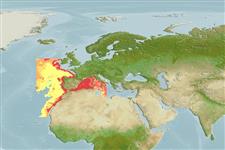>
Notacanthiformes (Halosaurs and deep-sea spiny eels) >
Notacanthidae (Deep-sea spiny eels)
Etymology: Notacanthus: Greek, noton = back + Greek, akantha = thorn (Ref. 45335).
More on author: Risso.
Environment: milieu / climate zone / depth range / distribution range
البيئة
بحري مياه عميقة; نطاق العمق 487 - 2000 m (Ref. 56504). Deep-water; 55°N - 20°N, 25°W - 17°E
Eastern Atlantic: Faeroes and Ireland to Cape Blanc, Mauritania including western Mediterranean (Italy). Reported from Iceland (Ref. 12462).
الحجم / وزن / العمر
Maturity: Lm ? range ? - ? cm
Max length : 26.0 cm TL ذكر/ مختلط الجنس; (Ref. 26178)
Hovers and swims along at slight head-down angle. Often caught in large numbers and possibly gregarious. Depth range from 700-2000 m and from 487-1034 m in the eastern Ionian Sea (Ref. 56504). Feeds on sessile and motile invertebrates such as bryozoans, ophiuroids, amphipods and sponges. Spawns in June-July in the Mediterranean. Sexually dimorphic, males generally smaller and with enlarged nasal rosettes (Ref. 4449).
Life cycle and mating behavior
النضج | التكاثر | وضع البيض | بيض | الخصوبة | Larvae
Sulak, K.J., 1990. Notacanthidae. p. 133-135. In J.C. Quero, J.C. Hureau, C. Karrer, A. Post and L. Saldanha (eds.) Check-list of the fishes of the eastern tropical Atlantic (CLOFETA). JNICT, Lisbon; SEI, Paris; and UNESCO, Paris. Vol. 1. (Ref. 4449)
IUCN Red List Status (Ref. 130435)
استخدامات بشرية
مزيد من المعلومات
الأسماء الشائعةمرادفاتالأيضمفتريساتعلم السميات البيئيةالتكاثرالنضجوضع البيضتجمعات وضع البيضالخصوبةبيضتطور البيضة
مراجعالأستزراع المائيملف الأستزراع المائيسلالاتجينيElectrophoresesالتوريثالأمراضمعالجةNutrientsMass conversion
المتعاونينصورStamps, Coins Misc.اصواتالتسمم باكل السمكسرعةنوع السباحةمنطقة الخياشيمعظمة الأذندماغرؤية
أدوات
تقارير خاصة
Download XML
مصادر علي الأنترنت
Estimates based on models
Preferred temperature (Ref.
123201): 7.7 - 13.6, mean 12.9 °C (based on 84 cells).
Phylogenetic diversity index (Ref.
82804): PD
50 = 0.5161 [Uniqueness, from 0.5 = low to 2.0 = high].
Bayesian length-weight: a=0.00182 (0.00087 - 0.00380), b=3.05 (2.85 - 3.25), in cm total length, based on LWR estimates for this species & (Sub)family-body (Ref.
93245).
مستوى غذائي (Ref.
69278): 3.9 ±0.1 se; based on diet studies.
المرونه (Ref.
120179): وسيط, الحد الزمني الأدني لتضاعف عدد أفراد المجتمع 1.4-4.4 سنة (Preliminary K or Fecundity.).
Fishing Vulnerability (Ref.
59153): Low vulnerability (16 of 100).
Nutrients (Ref.
124155): Calcium = 19 [4, 77] mg/100g; Iron = 0.333 [0.098, 1.121] mg/100g; Protein = 2.92 [0.00, 6.87] %; Omega3 = 0.18 [0.05, 0.61] g/100g; Selenium = 10.9 [3.3, 43.6] μg/100g; VitaminA = 37 [4, 304] μg/100g; Zinc = 0.566 [0.249, 1.390] mg/100g (wet weight);
